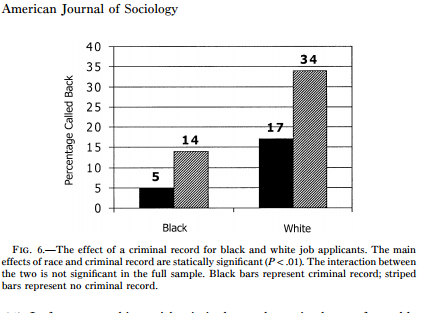The case of Milwaukee.—One key limitation of the audit study design is its concentration on a single metropolitan area. The degree to which the findings of each study can be generalized to the broader population, therefore, remains in question. In the present study, Milwaukee was chosen for having a profile common to many major American cities, with respect to population size, racial composition, and unemployment rate.
There are, however, two unique features of Milwaukee that limit its representativeness of other parts of the country. First, Milwaukee is the second most segregated city in the country, implying great social distance between blacks and whites, with possible implications for the results of the audit study. If race relations are more strained in Milwaukee than in other parts of the country, then the effects of race presented in this study may be larger than what would be found in other urban areas. Second,
Wisconsin had the third largest growth in incarceration rates in the country (Gainsborough and Mauer 2000) and currently has the highest rate of incarceration for blacks in the country (Bureau of Justice Statistics
2002b).
If the statewide incarceration rates are reflective of an especially punitive approach to crime, this could also affect the degree to which a criminal record is condemned by employers, particularly among black applicants. Of course, the only way to directly address these issues is through replication in additional areas. With respect to the main effect of race, previous audit studies have been conducted in Washington, D.C., Chicago, and Denver, confirming the basic magnitude of the effects reported here (Bendick et al. 1994; Turner et al. 1991; Culp and Dunson 1986). Likewise, a recent correspondence of the effects of race on a more restrictive sample
of occupations in Boston and Chicago produced strikingly similar estimates (Bertrand and Mullainathan 2002). These results, therefore, provide some indication that Milwaukee is not a major outlier in its level of racial discrimination in hiring.
In the case of the criminal record effect, only future studies can confirm or contradict the results presented here. As the first study of its kind, it is impossible to assess the degree to which these findings will generalize to other cities. Looking to existing survey research, however, we can gain some leverage on this issue. According to a recent survey conducted by Holzer and Stoll (2001), employers in Milwaukee reported substantially
greater openness to considering applicants with criminal records relative to their counterparts in Chicago, Los Angeles, and Cleveland. If these self-reports accurately reflect employers’ relative hiring tendencies, then we would expect the results of this audit study to provide conservative estimates of the barriers to employment faced by ex-offenders in other metropolitan areas.
Though it would preferable to include job vacancies derived from representative sources, it is difficult if not impossible to map the network of informal contacts that lead to most job opportunities. Instead, researchers have relied upon sources that allow for systematic and consistent sampling schemes, despite the reduction in representativeness. Following previous research, the present study relies upon a random sample of job openings
from advertised sources (the Milwaukee Journal Sentinel and Jobnet).
Fortunately, there is compelling research to suggest that the restricted sample provides a more conservative estimate of racial discrimination.
Firms who wish to discriminate, it is argued, are more likely to advertise job openings through more restrictive channels than the metropolitan newspaper, such as through referrals, employment agencies, or more selective publications (Fix and Struyk 1993, p. 32). Indeed, this argument is indirectly supported by research showing that minorities are more successful in job searches generated by general newspaper ads than through
other means (Holzer 1987). Further, pilot audits conducted by the Fair Employment Council in Washington, D.C., also indicate lower rates of discrimination against minorities in jobs advertised in metropolitan newspapers than those advertised in suburban newspapers or through employment agencies (Bendick et al. 1991, 1994).



